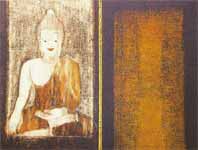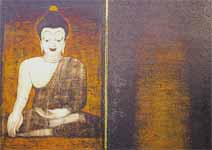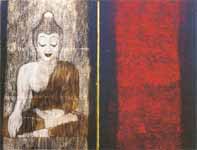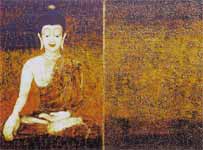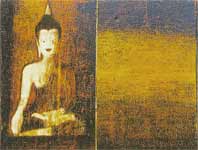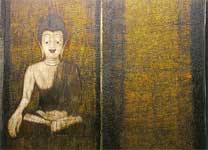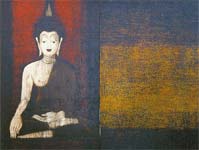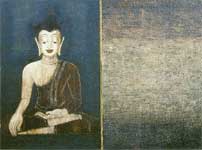The artist had
to persuade many organizations to cooperate and permit him to use the
temple space. For 5-6 years ago, he had to participate in many local activities
and Buddhism activities in order to be accepted.
In the opening day of “Anatta”, the monk’s leader jointed
the art exhibition with the art interested persons both Thai and foreigners,
and the local people as well.
In 2000, Rungroj exhibited the art exhibition named “Buddhanussati
50” in the main sermon hall at Suan Dok Temple. The exhibition was
comprised of 50 paintings of Buddha image, and the image of the biggest
Buddha in the temple.
This exhibition is the beginning of Buddhism experience, which inspires
him to create “Anatta” work of art.
Nowadays, 50 paintings of Buddha image belong to Singaporian collector.
And the image of the biggest Buddha in the temple is the property of the
lady Jumnongsri Hanjenlug, who donated it to Chiangmai University Art
Museum.
The stupa was in
Suan Dok Temple during 5-28 February 2002. It reflected the light, created
the shadow, and changed our feeling according to the time, which caused
the beauty scene, represented the Buddhism content and the local identity
by using accomplishment of art composition.
The stupa was reconstructed in Chiangmai University Art Museum during
7-31 March 2002 by using the eight paintings of Buddha image as the medium.
The concept of artist is never ending. The diference places cause difference
ideas.
So, “Anatta” can reflect fact and connect the art with the
local people and the local area such as temple. The work of art is not
limited to be in art gallery only.
Rungroj reveals the role of art to the public of that space. This is the
communicative process of the Buddhism roles. After the exhibition, the
24 days stupa would be disintegrated from tangible into intangible.
The creation of connection between local culture and contemporary art
concept is the accomplishment of worthy and the important of artwork in
the new meaning.
|
|
